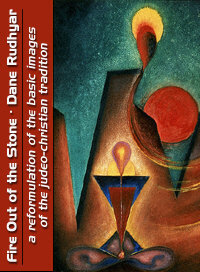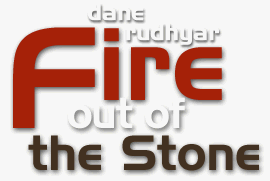 |
| Home | Bio | Art | Music | Literature | Civilization & Culture | Philosophy of Wholeness | Theosophy & Spirituality | Astrology |

FIRE OUT OF THE STONE A Reformulation of the Basic Images of the Judeo-Christian Tradition by Dane Rudhyar, 1962 1. Not to Repeat, But to Renew 2. The Essence and the Substance 3. To Become "More-Than-Man" 4. The Fatherhood of God 5. At the Center is Soul 6. Creation and Evolution 7. Crisis and Sin 8. The Coming-Together of God and Man 9. Christ-Love: The Covenant with Individual 10. The Life of Mediation and its Paradox • Page 1 • Page 2 • Page 3 • Page 4 • Page 5 • Page 6
: : :
This title was first published by Sevire, 1963. Cover for the online edition copyright © 2008 by Michael R. Meyer. : : : : : :
"Thy God is a cosumming fire." Duet. 4:25 "He shall baptize you with the Holy Spirit and with fire." Matthew 3:11 "I am come to send fire on the earth." Luke 12:49
: : :
|

10. THE LIFE OF MEDIATION AND ITS PARADOX - page 2"When man is as the woman and the woman as the man, there you will find me," Gnostic Saying of Jesus In many schools of "spiritual" endeavor the practice of meditation is advocated and definite rules are given for its pursuance. In terms of what is presented here "meditation" should be seen at best as a prelude to or a preliminary phase of the process of mediation. Any true and spiritually effective meditation has for its essential aim the raising of the individual consciousness to a level at which it ceases to be enmeshed in ego-patterns, and instead begins to partake in the vast process of universal evolution in the light of the soul. But alas many types of meditation merely replace egocentric patterns — if they do even that! — with dogmatic Images which freeze the process of mediation into collectivistic-religious Images of salvation. This may be a more secure and comfortable form of mediating soul-activity; and to the vast majority of "seekers" after spirituality it may indeed be the only reliable and safe way. Nevertheless the deepest and highest mode of mediating activity must always remain, at least as long as we deal with individual persons acting in the framework of our time-space universe, an activity which finds its focus in the acts of an individual. The individual is the lens; and though the light of all suns and stars be converging upon that lens, yet it is one single lens that focuses the multifarious rays of light. It is this great truth that the Christian Churches have materialized or personalized in the concept of the "one and only" Son of God. In every true act of mediation the mediator is, in terms of this act, "one and only" — even if the act has as preliminary condition the fulfillment of some actual relationship which, symbolically speaking, "sets" the lens correctly and polishes away its impurities while absorbing the diffidence and hesitancy of the consciousness which then is facing its greatest test of faith and courage. Everything ultimately rests upon, and is an expression of, the Principle of relatedness which is the core of "love". Every truly spirit-pervaded "meditation" serves to free the consciousness of the meditating individual from the obstacles to relatedness and love which the fears and the possessiveness or greed of the ego have built. Meditating upon "great truths" or universal symbols simply expands and makes more translucent the framework of a consciousness which accepts only what the ego-scaffolding surrounding its living core allows to come in or to get out. A man must fully accept the Truth of Man before he can love fully without ego-bent deviations and in freedom from social-ethical-cultural conditioning. Otherwise any mediating activity would be reduced to the level of his ego-controlled and so-called "personal" angle of vision. Every true mediator is therefore first of all "son of Man"; and it is only as son of Man that he can unite with the one Christ-principle and be transfigured by Christ-love, thus becoming, in the individualized manner which his time and place actually demand, a true mediator. There is no essential difference between creation and mediation. It is always the divine light penetrating and transforming the darkness of the end-results of as yet unresolved conflicts, results which in their ultimate aspect represent the condition of utter separateness and indifference to any possibility of relationship. This penetration of light is an act of true "love-charity." The light mediates between That which is conscious and compassionate Unity and the myriad points of darkness, residue of what failed to reach unity as it refused the love and relatedness which were its cyclic destiny (i.e. its potential of existence); and this mediation creates the possibility of a new future, because it reveals a new meaning, a new purpose. This mediation-creation is the central truth of the Christ-consciousness; and this is what, I repeat, distinguishes the Christian from the Buddhist ideal. The ideal which an undogmatic and essential Christianity presents is that of the man in whom the Divine has become focused in an activity which frees and transforms other man; an activity made possible by the "Marriage" of the Divine and of human nature within the field of actualization of the individualized soul. This ideally Christian life is thus a life through and within which opposites meet and interact. It is an "in-between" life. The interaction of these opposites reveals meaning; and this interaction revelative of meaning has its symbol in the chiaroscuro of the European painters of the Renaissance. The Christ-life is a chiaroscuro because it is neither light exclusively nor darkness exclusively, neither strictly divine nor strictly human; because it is both, and both meaningfully. Such an ideal of existence is, obviously, most dynamic; it is also most "insecure", because most unstable in its essential requirement that balance and integration be incessantly renewed and assured in the ever-fleeting moment. It may seem an apotheosis of change — and thus one may see its roots in the old Greek philosophy of Heraclitus. And yet what is presented as the supreme reality is not change as such! Change is only one pole; changelessness is the other pole. Every phase of existence changes into another and often into its opposite; yet the "harmony" of the ever-cyclic Whole is not affected. Its harmonic character is neither diminished nor increased; the Whole is not more nor less whole as a result of the interplay of its incomprehensibly vast multitude of parts intent upon working out ever-changing forms of relatedness. There is no static peace in this immense "dance" of ever-dissolved and ever-recreated relationships; Christ did not come to bring peace, but a "sword". There is no security; not because there is no God — as atheistic existentialists seek to believe in their tragic gesture of self-glorification as men — but because there is God and men; because therefore God must inevitably become "human" in polarizing man's efforts to become "divine". Nevertheless there is peace and security of a magnificent kind, just because there must appear to be none from the point of view of partiteness. Just because we are "parts", we can have faith in the Harmony of the Whole of which we are parts. It is only if we make ourselves believe that we are truly little wholes buffeted by the tremendous storms of universal energies that there is really no security and no peace. The tragedy inherent in the so much spoken of "human condition" is that we do not easily accept God and man, the changeless Harmony of the universal Whole and the fact that, while we have a sense of identity and wholeness as "I", we nevertheless are parts of this Whole, of this Harmony. We do not accept the relatedness of God and man, of man and God. We yearn to be divine, "spiritual", perfect; but we misunderstand the process by wanting to belittle and perhaps to erase our humanhood even while we are, here and now, men and women. We want to be divine first, whereas it is always the divine that has the initiative. We so want to be divine that when God knocks at the door we are usually so absorbed in our "meditation" or busy "doing good" and "saving people" (or cats and dogs!) that we do not hear the knocking. We so want to be what we actually are not, now — even if the potentiality of it is within us! — that we have no time for the process of relationship which alone can clear the way for and make possible the meeting with the Divine when Its time has come. And Its time may indeed not be the time our conscious self expects! It may not even be Nature's time, as we are told in the mysterious parable of the fig tree which was cursed by Jesus when he found on it no fruit to appease his thirst and hunger, even though it was not the season for bearing fruits. What a paradox! Indeed the life of ever-watchful, ever-ready response to the call for relatedness and harmonization through the unobstructed fulfillment of relationship is a constant paradox. It is, in another sense dear to contemporary thinking, a "dialectical" process — for the paradox is to the life of the spirit in focused activity what the syllogism (thesis — antithesis — synthesis) is to the logic of intellectual correlations. The life of a "disciple of Christ," the life of mediation, is a paradox because it is an "in-between" life; "in this world but not of this world" is another way of putting it (John 17). It is a life of dynamic integration of opposites; but out of this integration comes an expanding sense of meaning and purposefulness. Every effort man makes along the way of Christ-like relatedness tends to bring its opposite into play, and it can only be effective through the experience of the opposite. Peace, in this sense, can only be consciously realized and actualized through some form of "war", but only when war can be made significant as the womb of a greater sense of more-inclusive peace. God can only be experienced actually where man is most "human", and only when Man is understood as that field of dynamic existence in and through which God is to take individual form in the perfection of all-inclusive Christ-love.  Home | About | Calendar | Ephemeris Charts | Art Gallery | Library | Resources Shop | Rudhyar Archival Project | Help Web design and all data, text and graphics appearing on this site are protected by US and International Copyright and are not to be reproduced, distributed, circulated, offered for sale, or given away, in any form, by any means, electronic or conventional. See Notices for full copyright statement and conditions of use. Web design copyright © 2000-2004 by Michael R. Meyer. All Rights Reserved. |